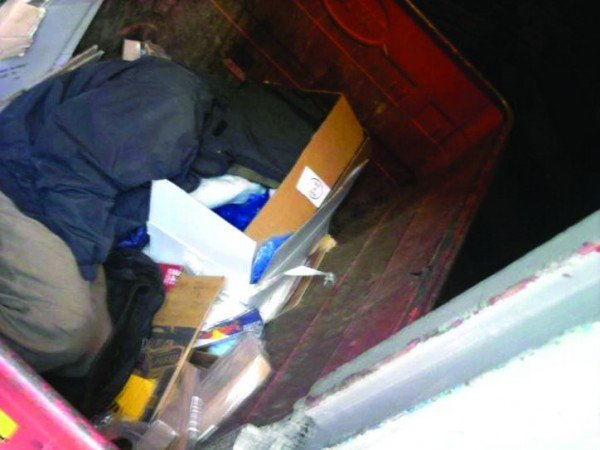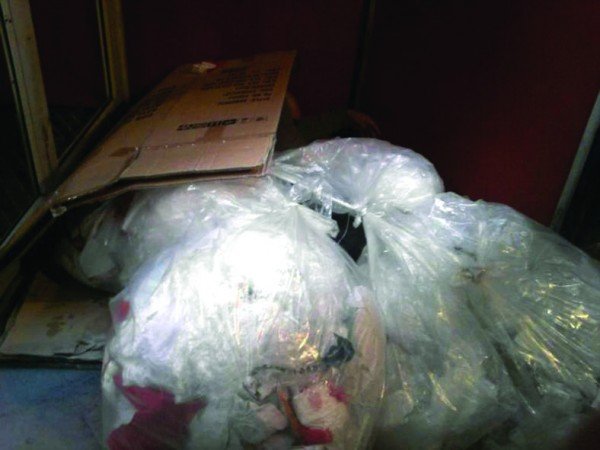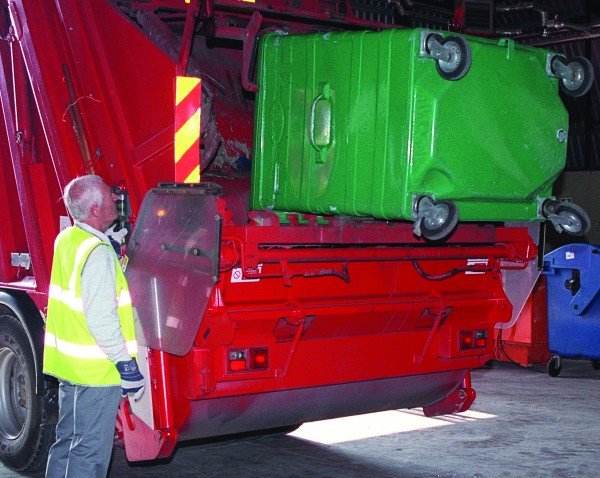
Someone sleeping in a container. Photo: Environmental Services Association
The waste and recycling industry has dealt with a series of shocking deaths in recent years. But as Stephen Freeland reports, these fatalities have not just been among employees but, alarmingly, have also involved members of the public sleeping or seeking refuge in waste containers.
People are placing themselves at serious risk of harm by sleeping or seeking refuge in waste containers. If undiscovered during the collection and tipping of the container into the back of a refuse collection vehicle, the chances of survival are very slim.
Unfortunately, such incidents are an all too often occurrence, and while most people are found before they come to any harm, the sad fact is that 11 people have been killed in such circumstances over the last five years, generally suffering the most horrific crushing injuries.
The circumstances surrounding such incidents vary considerably. On the one hand, the homeless and most vulnerable in society, when left with little other choice, are routinely sleeping rough in waste containers. As national policy drives businesses towards greater recycling and segregation of waste at source increasing amounts of recyclables are being presented for separate collection.
Understandably, containers filled with clean, dry recyclables such as paper and card present a comparatively more comfortable prospect for those sleeping rough than a container filled with mixed or food waste. There are also reports of people (generally children coerced by adults) being found in clothes banks where, having attempted to remove the clothes within, have found themselves stuck in the container, or sustaining serious injury.
Perhaps more surprisingly, a significant proportion of incidents and deaths are not associated with homeless people at all, but individuals with permanent residence and employment. Unfortunately, there have been tragic incidents where people have sought refuge in a container following a social event or night out and, often under the influence of drink or drugs, have remained unconscious during the tipping of the container into the refuse vehicle.
Most people tend to be found in commercial waste 1,100 litre recycling bins or FEL (front-end-loader) containers and such incidents are not necessarily confined to the cold, winter months. A spike in reported incidents during late spring of last year served to demonstrate that the waste management industry and those organisations that generate waste in the first place must remain vigilant all year round.
A significant problem
The scale of the problem is not entirely well known, although one national operator recently reported having found more than 90 people in its bins during the course of last year. A recent survey (conducted by Biffa and the Chartered Institution of Wastes Management, in partnership with Street Link) of waste management operators helped shed further light on this issue and, unsurprisingly, revealed that most incidents occurred in urban areas and during the hours of darkness. However, perhaps more worryingly, the report also found that in more than 40 per cent of reported incidents collection crews did not discover the individual until the tipping process was being undertaken.

Person hidden in recycling. Photo: Environmental Services Association
The matter is of such significance that HSE published guidance advising that potential harm and injury could be reduced through risk assessment and control measures. Where it can be shown that there is an increased risk of people seeking shelter in waste containers (i.e. areas of deprivation or past experience of people in containers; bins located in quiet, isolated areas of customer premises; or in poorly or unlit areas of the site), HSE advised that procedures should be deployed for checking bins on collection. A range of measures was suggested, which at the most fundamental level includes banging on the side of the container to rouse anyone inside before the bin is lifted.
Much to the industry’s consternation, this guidance was withdrawn as part of a wider government review of the regulatory burden on UK businesses. However, the industry eagerly awaits its reinstatement under the auspices of WISH – a forum of health and safety representatives, which aims to improve health and safety standards across the waste management industry. Once reinstated, the guidance should not only help raise awareness of this issue but also continue to offer practical assistance to waste management companies in discharging their relevant duties.
Responsible waste management operators continue to take steps to resolve this issue, regardless of the status of official guidance on ‘people in containers’. Some operators have trained their collection crews and drivers to check each and every bin, irrespective of the perceived risk of someone sheltering inside. Waste management operators continue to engage staff to help raise awareness of the issue, to ensure that collection crews remain vigilant and are trained on procedures which can help increase the chances of discovering people before the container is lifted and tipped into the refuse vehicle.
Control measures
Of course, even with the most robust procedures in place there is no guarantee that each and every person will be found, and some companies are therefore deploying more sophisticated techniques, such as the use of CCTV. Fitted to collection vehicles (or within the hopper) this can provide an additional control measure should an individual fail to be discovered prior to tipping. Options for in-container smart technology are also currently being explored.
Other possible control measures include training drivers and collection crews to look for ‘tell tale’ signs around a container that there might be someone sheltering inside (i.e. personal belongings, blankets or evidence around the container that the waste within has been disturbed). Some companies have placed warning signs on their containers, advising on the dangers to help deter people from accessing the bin in the first place. Training staff on the importance of reporting all such incidents helps companies to build up a better picture of the extent of the problem and allows resources to be targeted on ‘hot spot’ towns or areas.
While the waste management industry clearly has a role to play, a partnership approach is more likely to deliver positive outcomes. The legal responsibilities of businesses themselves – those that produce waste in the first place – are often overlooked.

A container being emptied. Photo: Environmental Services Association
Businesses have a legal duty of care to look after their own waste, and are responsible for ensuring that containers (and waste) are secure, both during storage and upon being presented for collection. Secure, locked storage areas should be used by businesses where available but where such facilities are not available, basic housekeeping measures could help reduce the likelihood of people accessing containers.
Care should therefore be taken to avoid overloading containers with so much material that it prevents the lid from shutting and being securely locked. If waste cannot be securely contained within the bins provided, then businesses should contact their service provider to discuss additional capacity requirements or to arrange for more frequent collections. Businesses should also alert their service providers to any concerns that waste containers are being used by homeless people or revellers.
The industry is committed to reducing harm to all those associated with its activities, employees and the public alike. Sharing best practice within the industry has long been recognised as one means by which to improve our health and safety performance and this should extend to forming new partnerships with the homeless charities sector and others with the ultimate aim of ensuring that people are aware of the risks and seek more suitable alternatives than taking refuge in a bin.
Stephen Freeland is policy advisor at the Environmental Services Association
The Safety Conversation Podcast: Listen now!
The Safety Conversation with SHP (previously the Safety and Health Podcast) aims to bring you the latest news, insights and legislation updates in the form of interviews, discussions and panel debates from leading figures within the profession.
Find us on Apple Podcasts, Spotify and Google Podcasts, subscribe and join the conversation today!




